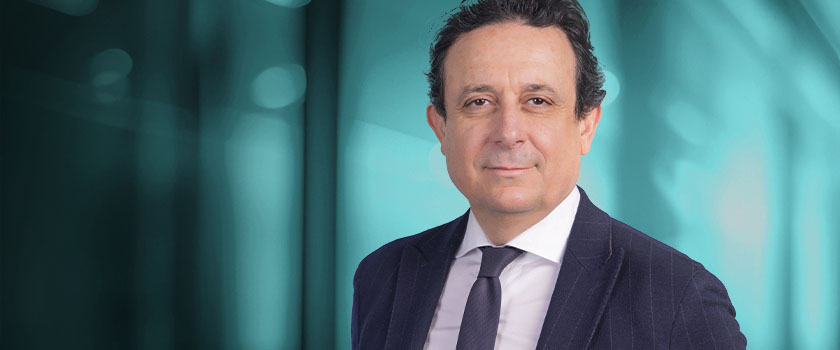Finanz und Wirtschaft (17.01.2022) - Norman Villamin, CIO Wealth Management of Union Bancaire Privée, expects a radical shift in monetary policy. A tightening cycle is less bad for equities than for bonds and gold, he says.
Mr. Villamin, futures markets are pricing in three to four rate hikes by the Fed this year. Do you share this view?
In a situation like this where inflation is high and unemployment down, you would expect an aggressive policy response. Three to four hikes is possible, but it is a risky strategy. The Fed may instead opt to raise rates at a more measured pace, maybe in March and in June, but then shift its tightening policy towards shrinking the balance sheet more aggressively than in 2017 when it sold 30 to 40 bn $ monthly.
Why should the Fed already begin to reduce its bond holdings, a policy known as quantitative tightening or QT, instead of using the Fed funds rate to tighten monetary policy?
Typically, in an environment with elevated inflation and strong growth, the yield curve tends to be steep. But today, the difference between the 10-year and the 2-year yield is only about 80 to 90 basis points. As you can read in the Fed’s most recent minutes, some Fed members are concerned that moving rates too aggressively may flatten the yield curve further or even invert it. The Fed has many tools to tighten the policy and I think relying more on shrinking the balance sheet serves the goals better than raising rates aggressively in the current cycle.
What goals are you referring to besides taming inflation?
Financial stability in general, and preventing excesses and credit stress in the housing market in particular. Residential property prices in the US have risen with a compound annual growth rate of 12–13% over the past two years. Over the last 40 years, this has happened only three times. In the late 80s, before the savings and loans crisis, in the run-up to the subprime mortgage crisis of 2007, and most recently in 2013–14.
By allowing long bond yields to rise, the Fed can attempt to create a soft landing as seen after 2014 and prevent systemic credit stresses from threatening the financial system.
Wouldn’t that hurt the economy and the financial markets too much?
The last and only time the Fed sold its bond holdings was in 2017 and 2018. That pushed up long-term yields by 80 to 100 basis points. Somewhat higher yields would help slow the housing market to prevent long-term damage while other segments can keep the overall economy going. A yield move of this size may also be good for global markets in the medium term as they are currently seeing signs of overheating because a lot of government bonds’ yields are still deeply negative when adjusted for inflation.
But the tide has turned. US monetary policy is less supportive.
Indeed, central banks have calibrated policy since the Global Financial Crisis in such a way to, at times, let asset prices rise in order to get the economy going and, when appropriate, avoid asset price inflation and overheating by taking measures to curb growth. In 2020 and early 2021, they were focused on getting growth going while accepting a little bit of inflation on the asset price side; now the pendulum has begun to swing to the other side.
The prospect of QT scares investors. Should they be worried?
Looking at the Fed’s tightening cycles since 1970, equity investors still made money in these periods but have had to bear more volatility. For 2022 you won’t see another 25% return in equities, rather something closer to 8 to 10% with a lot more ups and downs. Rate hikes and monetary tightening are not necessarily a bad thing for equities, whereas they are more challenging for fixed income investors. With bonds, investors have historically during Fed tightening cycles faced not only higher risk-free yields but, over the past decade in particular, wider credit spreads as well. With coupons still very low, the combination can erode returns for bond investors very quickly.
What kind of equities perform better when central banks start tightening – value or growth stocks?
We have already seen a sharp rotation from growth to value and more cyclical stocks since November, and that might reverse like it did last year.
The key question today is less about value vs. growth. Instead, it is about how investors manage the volatility that lies ahead. The answer, we think, is to focus on reliable earnings.
Why is that so important?
Typically the Fed tightens monetary policy when growth is strong; that means earnings tend to be strong but with higher rates, price–earnings ratios tend to contract. If investors focus on reliable earnings while avoiding too large a compression in price-earnings ratios, then they can achieve a much smoother return profile to face the volatility seen during these tightening cycles.
Stocks from these kinds of companies are usually traded at high multiples.
Sometimes. However, as we saw at the start of 2021, many investors worried about valuations being high and they did indeed come down over the course of the year. But earnings growth was strong enough to offset this and provide investors with a good overall return picture. That’s why we believe the key for investors is owning stocks that deliver earnings they have confidence in, which then can serve to offset against any decline in valuations.
With such an approach you do not buy stocks from companies which are not profitable but which have huge potential and a new technology, and hence you miss out on the Apples and Amazons of tomorrow.
It is not that we do not buy these types of companies. Instead, we try to make sure we have reasonable expectations about what they can deliver and over what time horizons. With these types of stocks you have to take a different approach: You must ask yourself if you can bear massive drawdowns of perhaps 60–70% or even more, because that is common in the early stages of such transformational industries. For example, even if you knew in 1999 with certainty that online retailing would be what it is today and had bought the leading company, you would have had to suffer drawdowns of 90% before the industry matured.
So when investing in these types of transformational themes, investors need to focus on identifying quality companies that may be the ultimate winners, sizing positions so that they can weather this type of volatility, and then make sure they keep the appropriate time horizons in mind when volatility emerges.
Unfortunately, many investors treat these positions like all the other positions in their portfolios.
How does gold fare during a tightening cycle?
We expect gold may have a hard time. Even if inflation does not come back quickly, the US central bank has signalled its intent to increase real yields. And rising real yields are typically bad for gold.
Gold already had a hard time last year, even as inflation rose and real yields went down. What went wrong?
There are different factors. One is the unique character of the Covid-19 recession. It was the deepest though shortest recession in history as well as being followed by the sharpest recovery. In a normal recession, typically there is a longer period with falling real yields and earnings uncertainty. That is when investors allocate money to gold. In 2020 real yields collapsed and gold went up, as one would normally expect. But shortly after, with the surge in stimulus, investors had earnings visibility and more attractive opportunities in equities to capture their interest. Another piece of the puzzle is that younger investors went into bitcoin as their preferred store of value instead of gold.
Commodities are running hot. Are we soon to see oil at 100 $ per barrel?
The oil price could go up to 100 $ because the re-opening surge in activity spurred demand for crude, while at the same time OPEC+ has been very disciplined in curbing supply. The country from Opec+ want prices to remain high to help them make the transition to a net-zero carbon global economy in the decades ahead. Paradoxically, a part of the surge in price comes from the move to decarbonise. Banks in Europe and around the world are increasingly incorporating climate impacts into their lending decisions, helping to constrain exploration and production activities and limiting future supply. On the demand side, many of the investments required for the green transition will require energy-intensive production of steel and other inputs that today still rely on carbon-based fuel sources.
Do you see similar patterns in other commodities?
The green transition is an obvious secular demand driver which is being matched by supply tightness among key commodities like copper and lithium. However, the global economy is also in the midst of a reshaping of global supply chains in light of the pandemic as companies seek to diversify as well as bring supply chains closer to home. This means a new and different capex cycle compared to recent history. Since 2000, capex has been very tech-focused – essentially adding new servers.
Looking ahead, this new cycle will require full factories to be built closer to home, requiring not only more traditional, ‘dirty’ commodities as inputs but also more 21st-century ‘commodities’ such as microchips to build these ‘smarter’ and greener, next-generation plants.









